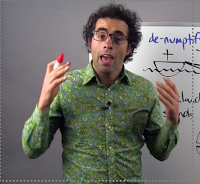
Geoff Simmons of the Morgan Foundation tells a good story about dodgy uncle Trev, fake bank notes and real moro bars while he fact-checks Paula Bennett on the integrity of the surplus emission units. It’s a real triple-dip!
The Morgan Foundation’s Geoff Simmons has done a whiteboard Friday video on Minister for Climate Change Issues Paula Bennett’s claim that the surplus emission units are not tainted by the 97 million fake Russian and Ukrainian emission reduction units that the Climate Cheats report of April 2016 showed had been handed to the Government under the NZ emissions trading scheme.

Geoff explains the issue very well and has the numbers right. More than that, I think Geoff should get the Joe Romm language intelligence award for using a great metaphor for New Zealand’s unethical use of the ‘hot air’ Ukrainian and Russian emission reduction units.
Dodgy uncle Trev’s fake twenty dollar note.
Your dodgy uncle Trev gives you a twenty dollar note. It looks like a ordinary twenty dollar note, but knowing uncle Trev, you have your doubts. Anyway, you use the dodgy note to buy a moro bar at a dairy and get back seventeen dollars change in valid notes. The dairy owner now has a fake twenty dollar note in the till. You have eaten the real moro bar. You still have seventeen real dollars. You could buy more moro bars.
[youtube https://www.youtube.com/watch?v=ezorBTHBuGo&w=560&h=315]
Obviously the fake twenty dollar note represents the emission reduction units. Replace uncle Trev with the Ukrainian and Russian joint implementation projects and the carbon brokers.
The purchase of the moro bar stands in for the emitters surrendering the ‘el-cheapo’ emission reduction units to the Government under the emissions trading scheme. And also for the Government then using the ‘el-cheapo’ emission reduction units that it holds to comply the Kyoto Protocol 2008 to 2012 target.
The seventeen real dollars (and the moro bar) are the legally valid ‘surplus’ assigned amount units that the Government is now ‘using’ to meet both the 2020 and (some of) the 2030 emissions reduction targets. The Government has, in effect, used the post Kyoto unit surrender mechanism to ‘launder’ the dubious emission reduction units from the emissions trading scheme into valid surplus assigned amount units held in Government accounts.
Arguably, Bennett’s intentions are ethically worse than the fake-note-moro-bar metaphor. Bennett is going for a “triple dip” of using surplus/dodgy units to ‘comply’ with three different emissions targets in spite of the upward trend in New Zealand’s GHG emissions.
Dip 1: the Kyoto Protocol 2008 – 2012 target
Dip 2: the UNFCCC ‘minus 5%’ 2013 – 2020 target
Dip 3: the Paris Agreement 2020 – 2030 target.
You can verify for yourself that the Government intends to do some creative accounting with the surplus units so that they allow greenhouse gas emissions to increase out to 2020 while the Government can claim that New Zealand is ‘meeting’ it’s “minus 5%” emission reduction target. Just go to Latest update on New Zealand’s 2020 net position on the Ministry for the Environment’s website.
That webpage states explicitly that New Zealand will have 85.7 million emission units surplus to use out to 2030 after using some to meet the 2020 target. Here is a screenshot.
Further down the page is this barchart that shows that New Zealand’s gross emissions from 2013 to 2020 are expected to be 655.9 million tonnes and that the baseline is 509.8 million tonnes. I have somewhat crudely marked the increase in emissions on the left hand bar.
I fully agree with Geoff Simmon’s conclusion. It’s simply unethical to make a monetary gain from fake currency. Just as you should wipe the moro bar crumbs off your shirt and give the dairy owner back the seventeen dollars (or a real twenty) in place of the fake note, Paula Bennett and the Government should cancel the surplus units instead of explicitly using them to meet targets while emission volumes increase. And we should make sure we never ever again rely on an uncapped internationally linked emissions trading approach for our climate change policy.



The dodgy carbon credits came about because Russia had a high allocation of credits for its old industries but when the economy collapsed they had far more than they needed and sold them cheaply to any country that wanted them. The fact that New Zealand started using them in quantity to avoid making any improvements to its carbon emissions is just part of the whole “do nothing” attitude by the NZ government to the problems of climate change and our growing emissions.
The only saving grace in the disreputable mess is that I firmly believe that the growth of cheap renewable energy has bankrupted the coal industry and now will be used to power our transport at such low rates that oil is finished as well. The Tesla car has shown the traditional car manufacturers that there is a massive demand for electric cars and unless they get into production quickly they will go the same way as the cart builders and the buggy whip.